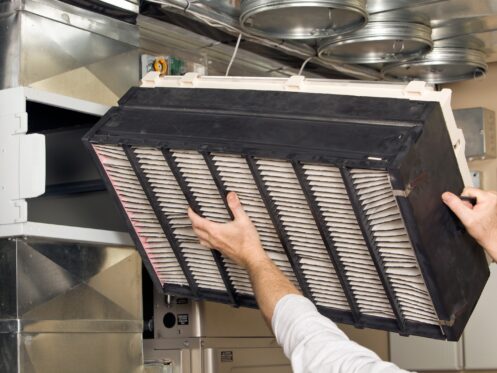People often consider things like diet, exercise and sleep quality when they think about their health. Indoor air quality is also something that can impact health and well-being. If you’re someone who suffers from allergies, asthma or other respiratory issues, poor indoor air quality can flare your symptoms.
Potential Allergens
Several types of indoor contaminants can result in allergy symptoms. For instance, many homes deal with high concentrations of pet dander, dust, dust mites and mold spores. When these particulates circulate through your home, this can lead to symptoms such as sneezing, coughing, itchy eyes and shortness of breath.
Chronic Symptoms
In addition to allergic reactions, poor indoor air quality can also cause chronic issues like headaches, fatigue, joint pain, vertigo and brain fog. These symptoms may temporarily get better when you’re outside the home if indoor air quality is to blame.
Long-Term Health Consequences
Long-term exposure to indoor contaminants can lead to serious health problems. Volatile organic compounds (VOCs) are off gassed from products that contain harmful chemicals. This includes certain cleaning products, new building materials, air fresheners and beauty products. Many of these VOCs can increase your risk of cancer, cause cardiovascular problems and lead to neurological damage.
Emotional and Mental Health
When you aren’t feeling well, this can increase the amount of stress you experience. When stress is chronic, this can lead to anxiety and depression. You may have trouble concentrating or being productive. Exposure to certain types of indoor contaminants can also lead to hormone disruption in the body, which can cause mood changes.
Mold Problems
Mold can grow in your home because of several issues. For mold to grow, moisture must be present. This moisture can come from high levels of relative humidity, plumbing leaks, foundation problems and more. Mold can cause severe allergic reactions, breathing problems, asthma attacks, dizziness and nausea.
If you discover mold is present in your home, you’ll want to work with a professional to remedy the situation. Safe mold remediation is necessary to protect your health and the health of your family. You should also take appropriate steps to control moisture problems so that mold cannot grow again in the future.
Improving Your Indoor Air Quality
If you’re concerned about the quality of your indoor air, there are several ways to improve IAQ.
Whole-House Air Filtration
Our team can install a whole-house air purification unit onto your HVAC system. As air passes through your HVAC system and ductwork, advanced filtration will remove particulate matter. This equates to cleaner air throughout your home.
Many of these purification units use high-efficiency particulate air filters, or HEPA for short. This type of filter can remove as much as 99.97% of the particulate matter in your air. This includes pet dander, pollen and even bacteria. HEPA filtration isn’t usually used in furnaces because of how restrictive it can be. It would cause system strain and potentially lead to heating and cooling equipment damage.
Another type of filtration used in purification units is activated carbon. Unwanted impurities in your air are attracted to the surface of the filter. Carbon is very porous, making it a great way to purify your indoor air. This is also a great way to get rid of odors from cooking, smoking or pets.
Furnace Filters
The filter in your furnace should be changed approximately once every 30 to 90 days. There are different types of filters available, with different recommended time frames for replacement. In between changes of your filter, do periodic checks to see if your filter is clogged or coated in debris. People who suffer from allergies often change their furnace filters at a more frequent rate to promote healthy indoor air quality.
There are washable filters that eliminate the need for buying expensive replacement filters. However, allergy sufferers often feel like these filters cannot be cleaned thoroughly. It may be better to purchase new filters to ensure optimal indoor air quality.
Consider Indoor Humidity Levels
The relative humidity in your home will vary depending on the weather outside and the conditions in your home. Relative humidity should always remain between 35% and 50%. You can monitor relative humidity using a hygrometer. Some smart thermostats are equipped with this technology, allowing you to conveniently monitor indoor humidity using your smart device.
You can remove add moisture to our dry Utah air your indoor air using a whole-house humidifier. This equipment is much more effective than a portable model. It addresses all the air passing through your HVAC system. A portable model tackles moisture in a small area at one time. A whole-house humidifier can add moisture back into your air if relative humidity is below 35%, which can be soothing to irritated sinuses.
Ventilate Your Home
Avoid allowing contaminants to build up in your indoor air by using ventilation. On nice days, this may include opening windows and doors. If the outside air isn’t safe because of pollution, ozone or high levels of pollen, there are other ways to promote ventilation. Run your exhaust fans periodically throughout the day. You likely have these fans in your bathroom and kitchen. They’re ideally used when bathing and cooking to remove high levels of humidity and particulates from your home.
You can have ventilation equipment installed in your home as well. Energy recovery ventilation systems are ideal for exchanging stale indoor air with fresh air. You can use this equipment along with whole-house purification units to remove any potential leftover contaminants.
Make Healthier Choices
There are healthier alternatives to chemical-based products. When it comes to cleaning, choose products that contain natural ingredients. You can even make your all-purpose cleaner from vinegar and water. Instead of using chemical fragrances as air fresheners, use an essential oil diffuser. Better yet, install an air purifier that cleans airborne particulates and pathogens. This will make your home smell fresher.
If you’re going to be doing any kind of construction work in your home, there are green building materials that contain little to no volatile organic compounds. You can off-gas new products outside your home for some time to reduce the number of VOCs that are in your indoor air.
Indoor Air Quality Assessments
To figure out what is impacting your indoor air quality, you should consider scheduling an indoor air quality assessment. Samples from different surfaces and areas of your home will determine what kind of particulate matter is in your air. You can use this information to make future decisions that will promote healthier IAQ.
Consider periodic testing to ensure you’re maintaining optimal indoor air quality. There may be new contaminants that become a problem. You’ll also want to confirm that the IAQ methods you’re now using are working effectively.
You can utilize the assistance of Blue Best Plumbing, Heating, Air, & Generators to achieve healthy indoor air quality in your home. Our team can provide routine maintenance and repairs for your heating and cooling equipment to ensure you can use this equipment to keep your home comfortable and healthy. We can also install whole-home air purification equipment to remove particulate matter from your indoor air.
Contact Blue Best Plumbing, Heating, Air, & Generators in Bountiful, UT today to schedule an appointment.








